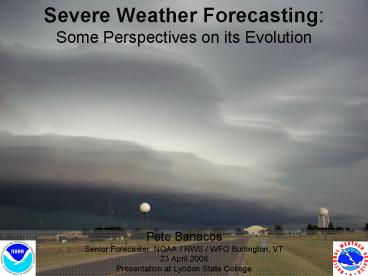Severe Weather Forecasting: Some Perspectives on its Evolution - PowerPoint PPT Presentation
1 / 15
Title:
Severe Weather Forecasting: Some Perspectives on its Evolution
Description:
Field Projects. Thunderstorm Electrification and Lightning Experiment (2003-2004)? The Thunderstorm Project, 1946-47. 1st large-scale investigation of thunderstorms ... – PowerPoint PPT presentation
Number of Views:46
Avg rating:3.0/5.0
Title: Severe Weather Forecasting: Some Perspectives on its Evolution
1
Severe Weather ForecastingSome Perspectives on
its Evolution
- Pete Banacos
- Senior Forecaster, NOAA / NWS / WFO Burlington,
VT - 23 April 2008
- Presentation at Lyndon State College
2
OUTLINE OF PRESENTATION
- Why Forecast Severe Weather?
- First Successful Tornado Forecast
- Severe Weather Milestones and Field Projects
- Convective Forecast Process
- Beyond 3 hrs
- Within 3 hrs
- Forecast Intangibles
- Future Forecast Challenges
Developing deep moist convection, 26 May 1997 (P.
Banacos)?
Mulvane, KS tornado, 12 June 2004 (J. Guyer)?
3
MY PARCEL TRAJECTORY
- LSC, B.S. Meteorology 1996
- Univ. of Oklahoma, M.S. Meteorology 1999
- NCEP/Storm Prediction Center, Assistant Mesoscale
Forecaster (2000-2005)? - WFO Burlington, VT, Lead Forecaster (October
2005-Present)?
Supercell forward-flank downdraft, Wilson, KS 11
May 1998 (P. Banacos)?
4
WHY FORECASTSEVERE (CONVECTIVE) WEATHER?
- Entire nation affected throughout the year
- 400 deaths and 25 billion damage in U.S.
annually - 80 of presidential disaster declarations
annually
TRI-STATE, 1925
MONTICELLO, IND 1974
WACO, TX 1953
ST LOUIS, 1896
(STATISTICS FROM MOLLER, 2001 SEVERE LOCAL
STORMS FORECASTING, IN SEVERE CONVECTIVE STORMS,
C. A. DOSWELL III, ED., AMER. METEOR. SOC.)?
5
SUPER TUESDAY OUTBREAK OF 2008
- 90 Tornadoes, at least 55 Fatalities
Day 2 Convective Outlook Issued 17z 2/4/08
6
Severe Convective Weather Includes More Than
Tornadoes
- Hail (3/4 in. or greater)?
- High Winds (58 mph or greater)?
- Lightning (2nd leading killer)?
- Flash flooding (1 killer
- 100 U.S. deaths annually)?
(NOAA-NWS)?
(NOAA-NWS)?
7
The Tinker AFB Tornadoes of 1948
- 1st successful operational tornado forecast
- (25 March 1948 SE Oklahoma City)?
- Fierce tornado swept across the same base five
days earlier, 20 March 1948 (10 million dollars
in damage, 1948 dollars)? - AF Forecasters noted similarities in surface and
upper air charts from 5 days previous. - Tornado forecast issued at 250 pm, 25 March
- Destructive tornado touched down at Tinker AFB
6 pm (6 million in damage). - First step in establishing the organized warning
and watch program of today. - Capt. Miller would pioneer many empirical severe
weather forecast techniques through the 1970s.
L-R Maj. Ernest J. Fawbush and Capt. Robert C.
Miller, circa 1951
8
Organizational Time Line for Severe Weather
Forecasting
June 1966 Severe unit of SELS renamed National
Severe Storms Forecast Center (NSSFC) moved to
new downtown KC location.
25 March 1948 1st Successful Tornado
forecast Oklahoma City
9 March 1952 WBAN Severe Weather Unit Washington
D.C.
17 June 1953 SWU renamed the Severe Local Storm
Warning Service (SELS)?
1970
21 May 1952 Weather Bureau Severe Weather Unit
(SWU) Washington D.C.
1948
1 Sept 1954 SELS moved to Kansas City,
MO (teletype switching hub, closer to more svr
tstms, co-location with Aviation Forecasting
Center)?
9
Organizational Time Line for Severe Weather
Forecasting (cont.)?
1 October 1995 NSSFC renamed the Storm Prediction
Center and moved to Norman, OK in 1996
(co-location with NSSL).
1976 Techniques Development Unit (TDU) formed to
facilitate research results into operations.
1970
2008
August 2006 SPC moved into new National Weather
Center (NWC) facility.
National Weather Center Norman, OK
10
Severe Weather Forecasting ImprovementsHow do
they come about?
- Convective Field Programs
- Lead to better physical and conceptual knowledge
of storm processes. - Most advances arrive through having first
observed a process, then developing theory to
explain the observation(s). - Technological Advances
- Computing power (better, more-complex NWP
workstation displays)? - Diagnostic imagery (radar, satellite, lightning
detection, wind profilers, mesonets)? - Forecaster Experience / Knowledge Transfer
- Pattern Recognition, conceptual models,
filling-in-the-gaps - Empirical methods
- Communication among various working groups (e.g.,
map discussions)?
11
Field Programs
- Scale of Thunderstorm L 10 km, t 1 hr
- Field programs/experiments allow in situ
measurements that are otherwise unavailable. - Drawbacks Prolonged design/planning, expensive,
limited sample size
STEPS - Severe Thunderstorm Electrification and
Precipitation Study (2000) May 22-July 16, 2000
2003
Recent NSSL Field Projects
VORTEX - Verification of the Origin of Rotation
in Tornadoes Experiment (1994-95)
Thunderstorm Electrification and Lightning
Experiment (2003-2004)?
12
The Thunderstorm Project, 1946-47
- 1st large-scale investigation of thunderstorms
- Studied thunderstorms in Ohio and Florida used
surface and airborne measurements - Established conceptual model of well-known
thunderstorm life cycle (from Byers and Braham
1949)
Cumulus Stage
Mature Stage
Dissipating Stage
13
SubVORTEX,1998-99
- Scaled-down version of VORTEX field program
involving Doppler on Wheels (DOW) and three
mobile mesonet vehicles.
Is there something thermodynamically special
about hook echoes and RFDs associated with
tornadic supercells?
Obtain direct observations from here
14
(From Markowski et al. 2002)?
15
SubVORTEX Results
- Small ?e deficits in rear-flank downdraft of
supercells (1-4 K) more conducive for
tornadogenesis. - dual-polarized radar signatures unique to warm
RFDs ?
(From Markowski et al. 2002)?































